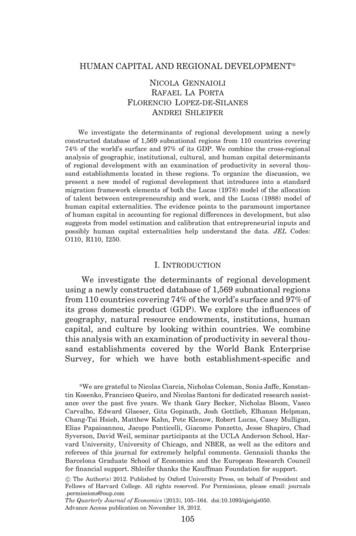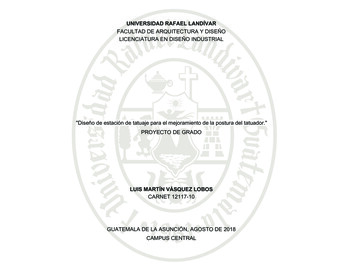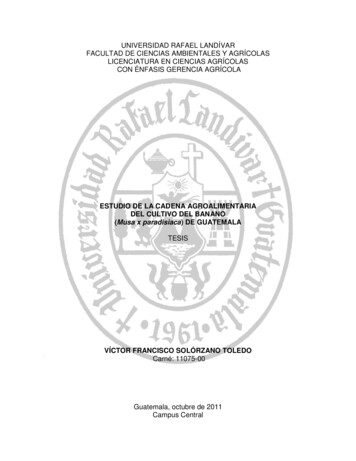
Transcription
HUMAN CAPITAL AND REGIONAL DEVELOPMENT*Nicola GennaioliRafael La PortaFlorencio Lopez-de-SilanesAndrei ShleiferWe investigate the determinants of regional development using a newlyconstructed database of 1,569 subnational regions from 110 countries covering74% of the world’s surface and 97% of its GDP. We combine the cross-regionalanalysis of geographic, institutional, cultural, and human capital determinantsof regional development with an examination of productivity in several thousand establishments located in these regions. To organize the discussion, wepresent a new model of regional development that introduces into a standardmigration framework elements of both the Lucas (1978) model of the allocationof talent between entrepreneurship and work, and the Lucas (1988) model ofhuman capital externalities. The evidence points to the paramount importanceof human capital in accounting for regional differences in development, but alsosuggests from model estimation and calibration that entrepreneurial inputs andpossibly human capital externalities help understand the data. JEL Codes:O110, R110, I250.I. IntroductionWe investigate the determinants of regional developmentusing a newly constructed database of 1,569 subnational regionsfrom 110 countries covering 74% of the world’s surface and 97% ofits gross domestic product (GDP). We explore the influences ofgeography, natural resource endowments, institutions, humancapital, and culture by looking within countries. We combinethis analysis with an examination of productivity in several thousand establishments covered by the World Bank EnterpriseSurvey, for which we have both establishment-specific and*We are grateful to Nicolas Ciarcia, Nicholas Coleman, Sonia Jaffe, Konstantin Kosenko, Francisco Queiro, and Nicolas Santoni for dedicated research assistance over the past five years. We thank Gary Becker, Nicholas Bloom, VascoCarvalho, Edward Glaeser, Gita Gopinath, Josh Gottlieb, Elhanan Helpman,Chang-Tai Hsieh, Matthew Kahn, Pete Klenow, Robert Lucas, Casey Mulligan,Elias Papaioannou, Jacopo Ponticelli, Giacomo Ponzetto, Jesse Shapiro, ChadSyverson, David Weil, seminar participants at the UCLA Anderson School, Harvard University, University of Chicago, and NBER, as well as the editors andreferees of this journal for extremely helpful comments. Gennaioli thanks theBarcelona Graduate School of Economics and the European Research Councilfor financial support. Shleifer thanks the Kauffman Foundation for support.! The Author(s) 2012. Published by Oxford University Press, on behalf of President andFellows of Harvard College. All rights reserved. For Permissions, please email: journals.permissions@oup.comThe Quarterly Journal of Economics (2013), 105–164. doi:10.1093/qje/qjs050.Advance Access publication on November 18, 2012.105
106QUARTERLY JOURNAL OF ECONOMICSregional data. In this analysis, human capital measured usingeducation emerges as the most consistently important determinant of both regional income and productivity of regionalestablishments. We then use the combination of regional andestablishment-level data to investigate some of the key channels through which human capital operates, including education of workers, education of entrepreneurs/managers, andexternalities.To organize this discussion, we present a new model describing the channels through which human capital influences productivity, which combines three features. First, human capital ofworkers enters as an input into the neoclassical production function, but human capital of the entrepreneur/manager influencesfirm-level productivity independently. The distinction betweenentrepreneurs/managers and workers has been shown empirically to be critical in accounting for productivity and size of firmsin developing countries (Bloom and Van Reenen 2007, 2010; LaPorta and Shleifer 2008; Syverson 2011). In the models of allocation of talent between work and entrepreneurship such as Lucas(1978), Baumol (1990), and Murphy, Shleifer, and Vishny (1991),returns to entrepreneurial schooling may appear as profits ratherthan wages. By modeling this allocation, we trace these two separate contributions of human capital to productivity.Second, our approach allows for human capital externalities,emphasized in the regional context by Jacobs (1969), and in thegrowth context by Lucas (1988, 2009) and Romer (1990). Theseexternalities result from people in a given location spontaneouslyinteracting with and learning from each other, so knowledge istransmitted across people without being paid for. Because ourframework incorporates both the allocation of talent betweenentrepreneurship and work as in Lucas (1978) and human capitalexternalities as in Lucas (1988), we call it the Lucas-Lucasmodel.1 By decomposing human capital effects into those ofworker education, entrepreneurial/managerial education, andexternalities using a unified framework, we try to disentangledifferent mechanisms.1. We do not consider the role of human capital in shaping technology adoption(Nelson and Phelps 1966). For recent models of these effects, see Benhabib andSpiegel (1994), Klenow and Rodriguez-Clare (2005), and Caselli and Coleman(2006). For evidence, see Coe and Helpman (1995), Ciccone and Papaioannou(2009), and Wolff (2011).
HUMAN CAPITAL AND REGIONAL DEVELOPMENT107Third, we need to consider the mobility of firms, workers, andentrepreneurs across regions, which is presumably less expensivethan that across countries. Our model follows the standard urbaneconomics approach (e.g., Roback 1982; Glaeser and Gottlieb2009) of labor mobility across regions with land and housing limiting universal migration into the most productive regions. Thisformulation allows us to analyze the conditions under which theregional equilibrium is stable and to consider jointly the education coefficients in regional and establishment level regressions.To begin, we examine the determinants of regional income ina specification with country fixed effects. Our approach followsdevelopment accounting, as in Hall and Jones (1999), Caselli(2005), and Hsieh and Klenow (2010). Among the determinantsof regional productivity, we consider geography, as measured bytemperature (Dell, Jones, and Olken 2009), distance to the ocean(Bloom and Sachs 1998), and natural resources endowments. Wealso consider institutions, which have been found by King andLevine (1993), De Long and Shleifer (1993), Hall and Jones(1999), and Acemoglu, Johnson, and Robinson (2001) to be significant determinants of development. We also look at culture,measured by trust (Knack and Keefer 1997), and ethnic heterogeneity (Easterly and Levine 1997; Alesina et al. 2003). Last, welook at average education in the region. A substantial crosscountry literature points to a large role of education. Barro(1991) and Mankiw, Romer, and Weil (1992) are two early empirical studies; de La Fuente and Domenech (2006), Breton (2012),and Cohen and Soto (2007) are recent confirmations. Across countries, the effects of education and institutions are difficult to disentangle: both variables are endogenous and the potentialinstruments for them are correlated (Glaeser et al. 2004). Byusing country fixed effects, we avoid identification problemscaused by unobserved country-specific factors.We find that favorable geography, such as lower averagetemperature and proximity to the ocean, as well as higher naturalresource endowments, are associated with higher per capitaincome in regions within countries. We do not find that culture,as measured by ethnic heterogeneity or trust, explains regionaldifferences. Nor do we find that institutions as measured bysurvey assessments of the business environment in theEnterprise Surveys help account for cross-regional differenceswithin a country. Some institutions or culture may matter onlyat the national level, but then large income differences within
108QUARTERLY JOURNAL OF ECONOMICScountries call for explanations other than culture and institutions. In contrast, differences in educational attainment accountfor a large share of the regional income differences within a country. The within-country R2 in the univariate regression of the logof per capita income on the log of education is about 25%; this R2is not higher than 8% for any other variable.Acemoglu and Dell (2010) examine subnational data fromNorth and South America to disentangle the roles of educationand institutions in accounting for development. The authors findthat about half of the within-country variation in levels of incomeis accounted for by education. This is similar to the Mankiw,Romer, and Weil (1992) estimate for a cross-section of countries.We confirm a large role of education and try to go further in identifying the channels. Acemoglu and Dell also conjecture that institutions shape the remainder of the local income differences. Wehave regional data on several aspects of institutional quality andfind that their ability to explain cross-regional differences isminimal.2In regional regressions, human capital in a region may beendogenous because of migration. To make progress, we examinethe determinants of firm-level productivity. We merge our datawith World Bank Enterprise Surveys, which provideestablishment-level information on sales, labor force, educationallevel of management and employees, as well as energy and capitaluse for several thousand establishments in the regions for whichwe have data. We estimate the production function predicted byour model using several methods, including Levinsohn andPetrin’s (2003) panel approach. The micro data point to a largerole of managerial/entrepreneurial human capital in raising firmproductivity. We also find that regional education has a largepositive coefficient, consistent with sizable human capital externalities. However, because regional education may be correlatedwith unobserved region-specific productivity parameters, we donot have perfect identification of externalities.To assess the extent to which firm-level results can accountfor the role of human capital across regions, we combine estimation with calibration following Caselli (2005). We rely on previousresearch regarding factor shares (e.g., Gollin 2002; Caselli and2. Recent work argues that regions within countries that were treated particularly badly by colonizers have poor institutions and lower income today(Banerjee and Iyer 2005; Dell 2010; Michalopoulos and Papaioannou 2011).
HUMAN CAPITAL AND REGIONAL DEVELOPMENT109Feyrer 2007; Valentinyi and Herrendorf 2008), but then combineit with coefficient estimates from regional and firm-level regressions. Our calibrations show that worker education, entrepreneurial education, and externalities all substantially contributeto productivity. We find the role of workers’ human capital to be inline with standard wage regressions, which are the benchmarkadopted by conventional calibration studies (e.g., Caselli 2005).Crucially, however, our results indicate that focusing on workereducation alone substantially underestimates both private andsocial returns to education. Private returns are very high but toa substantial extent earned by entrepreneurs, and hence mightappear as profits rather than wages, consistent with Lucas(1978). Although we have less confidence in the findings forexternalities, our best estimates suggest that those are also sizable. In sum, the evidence points to a large influence of entrepreneurial human capital, and perhaps of human capitalexternalities, on productivity.In Section II, we present a model of regional developmentthat organizes the evidence. In Section III, we describe ourdata. Section IV examines the determinants of both nationaland regional development. Section V presents firm-level evidence, and Section VI calibrates the model to assess its abilityto explain income differences. Section VII concludes.II. A Lucas-Lucas Spatial Model of Regional andNational IncomeA country consists of a measure 1 of regions, a share p ofwhich has productivity A P and a share 1 p of which has productivity A U A P . We refer to the former regions as ‘‘productive,’’to the latter regions as ‘‘unproductive,’’ and denote them byi P, U. A measure 2 of agents is uniformly distributed acrossregions. An agent j enjoys consumption and housing accordingto the utility function:ð1Þuðc, aÞ ¼ c1 j a j ,where c and a denote consumption and housing, respectively.Half the agents are ‘‘rentiers,’’ the remaining half are ‘‘laborers.’’Each rentier owns 1 unit of housing, T units of land, K units ofphysical capital (and no human capital). Each laborer is endowedwith h 2 R units of human capital. In region i P, U the
110QUARTERLY JOURNAL OF ECONOMICSdistribution of initial, exogenous human capital endowment isPareto in [h, 1), where h 1. We denote its mean value by Hiin region i P, U.A laborer can become either an entrepreneur or a worker. Byoperating in region i, an entrepreneur with human capital h hiresphysical capital Ki,h, land Ti,h, workers with total human capitalHi,h, and produces an amount of the consumption good equal to:ð2Þyi, h ¼ Ai h1 Hi, h Ki, h Ti, h , þ þ 1:As in Lucas (1978), a firm’s output increases, at a diminishingrate, in the entrepreneur’s human capital h as well as in Hi,h, Ki,h,and Ti,h. We model human capital externalities (Lucas 1988) byassuming that regional total factor productivity is given by:ð3Þ Ai ¼ A i Ei ðhÞ Li , 0, 1:According to equation (3), productivity depends on (a)region-specific factors A i , which capture geography, institutions,and other influences; (b) average human capital in the regionEi(h), computed across all laborers who choose to work in theregion, including migrants; and (c) the measure Li of labor inthat region. Parameter captures the importance of the qualityof human capital: when 1 only the quantity of human capitalrises the quality ofHi Ei(h)Li matters for externalities; ashuman capital becomes relatively
Florencio Lopez-de-Silanes Andrei Shleifer We investigate the determinants of regional development using a newly constructed database of 1,569 subnational regions from 110 countries covering 74% of the world’s surface and 97% of its GDP. We combine the cross-regional analysis of geographic, institutional, cultural, and human capital determinants of regional development with an examination of .











